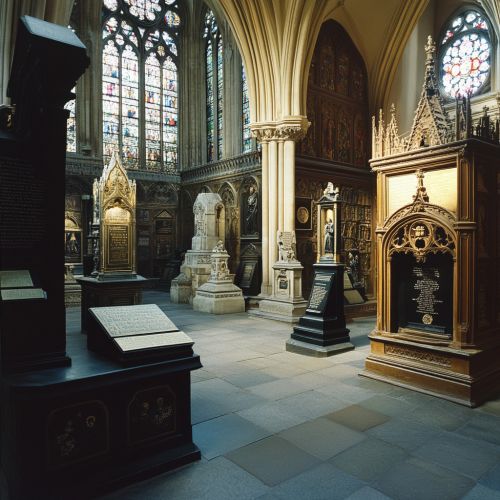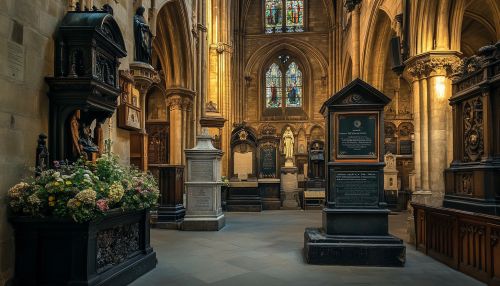Poets' Corner
Overview
Poets' Corner is a section of Westminster Abbey in London, England, dedicated to the commemoration of poets, playwrights, and writers. It is a place of significant historical and cultural importance, where many of the most celebrated figures in English literature are either buried or memorialized. The tradition of interring or memorializing writers in Poets' Corner began in the 14th century and continues to this day.
Historical Background
The origins of Poets' Corner date back to 1400, with the burial of Geoffrey Chaucer, often considered the father of English literature. Chaucer's interment in Westminster Abbey was not initially due to his literary contributions but rather because he was Clerk of the King's Works. However, his burial site became a focal point for the commemoration of literary figures, and over time, other writers were either buried nearby or memorialized with plaques and monuments.
Notable Interments and Memorials
Poets' Corner houses the remains or memorials of numerous illustrious writers. Some of the most notable include:
Geoffrey Chaucer
As previously mentioned, Chaucer's burial in 1400 marked the beginning of Poets' Corner. He is best known for "The Canterbury Tales," a seminal work in English literature that offers a vivid portrayal of medieval society.
William Shakespeare
Although William Shakespeare is buried in Stratford-upon-Avon, he has a prominent memorial in Poets' Corner. Erected in 1740, the monument features a statue of Shakespeare leaning on a pile of books, symbolizing his monumental contribution to English drama and poetry.
Charles Dickens
Charles Dickens, one of the most famous novelists of the Victorian era, is buried in Poets' Corner. Known for works such as "A Tale of Two Cities" and "Great Expectations," Dickens' burial in 1870 was a significant event, drawing attention to the importance of Poets' Corner as a national literary shrine.
Other Notable Figures
Other significant literary figures commemorated in Poets' Corner include John Milton, author of "Paradise Lost"; Jane Austen, known for her novels exploring the British landed gentry; and the Romantic poets William Wordsworth and Samuel Taylor Coleridge.
Architectural and Artistic Features
Poets' Corner is not just a burial site but also an area rich in architectural and artistic features. The monuments and plaques range from simple stone markers to elaborate sculptures. The design and craftsmanship of these memorials reflect the artistic styles of their respective periods, offering insights into the evolving tastes and cultural values.


Cultural and Educational Impact
Poets' Corner serves as a focal point for the celebration of English literature. It attracts scholars, tourists, and literary enthusiasts from around the world. The site is often included in educational curricula and literary tours, emphasizing its role in preserving and promoting the legacy of English literary giants.
Modern Additions
The tradition of commemorating writers in Poets' Corner continues into the modern era. Recent additions include memorials for poets such as Ted Hughes and Philip Larkin, reflecting the ongoing evolution of English literature. These modern memorials ensure that Poets' Corner remains a living, dynamic space that honors both historical and contemporary contributions to literature.
